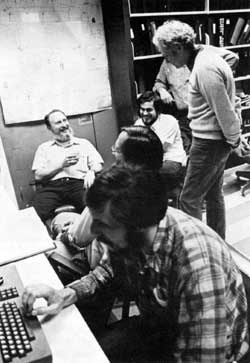Noise, Fog, Mean Successful A-Sector Test

Success is measured on the faces (left to right) of M. Hentges (at keyboard), P. Martin, G. Tool, D. Wolff, L. Lederman (standing), and P. Limon (background)
At approximately 3:30 p.m. Friday, February 19, the denizens of the east side of Wilson Hall were treated to a dramatic demonstration of the progress of the Energy Saver project. In the first major power test of the Energy Saver, all the A-sector magnets were successfully energized to a level corresponding to operation at 500 GeV and ramped to that level for 1-½ hours at a 72-second repetition rate. Before proceeding to higher levels, a "worst-case" test was given the sophisticated systems designed to rapidly remove the stored energy from the magnets in a controlled manner and to relieve the pressure built up in the helium. This procedure involved making all 94 dipoles in the system go normal (non-superconducting) at once by firing heaters in the magnets. The energy stored in the magnets dissipates by boiling the liquid helium used to keep them cold. The noise and fog seen from Wilson Hall were caused by cold helium gas escaping from relief valves on top of the refrigerators.
This spectacular success was accomplished through weeks of around-the-clock effort on the part of Saver and support group personnel who labored through a long summer and fall to install magnets, power supplies, refrigeration, controls, and associated equipment in the Al, A2, and A3 cryoloops - 118 magnets, 25 spool pieces, 3 refrigerators, and 4 compressors - plus the Central Helium Liquefier. Behind the opportunity to install and test are years of R&D, testing, and fabrication effort by the dedicated workers of Fermilab. In addition to the efforts of the Energy Saver, many people of the Laboratory devoted much time over the past several years to get us to where we are now. Included among these are the Proton and Meson Departments, the Bubble Chamber groups, people at Paramount Warehouse who built cryogenic components, and the Neutrino Department, Research Services, Radiation Physics, and the Physics Department who helped with electronics, power supplies, and the controls effort.
The operating groups of the Accelerator Division - the Main Ring, Booster, Linac, and Switchyard Groups - and the accelerator operators were of inestimable help in assembling and operating the Saver tests. Much of the R&D and fabrication work, and many of the tests are being carried out by the Accelerator Support Groups, particularly the Controls, Electrical, and Instrumentation Groups. The magnets were put into the tunnel and made leak-tight through the dedicated work and long hours of the Mechanical Support and Conventional Mechanical Devices Groups.
Through January the staff of the Energy Saver struggled to understand and master for the first time the simultaneous operation of three satellite refrigerators, compressors, and the vacuum system from the Main Control Room. The remote operation of this complex, interconnected system is made possible by the use of many microprocessors and computers, working in concert because of the heroic efforts of the Accelerator Controls Group.
After about two weeks were spent attempting to fill the 2400-foot string of magnets with liquid helium using only the three satellite refrigerators, the Central Helium Liquefier was put on line. Within six hours the magnets started to fill, and ten hours later the system, about one-eighth of the complete Energy Saver, was filled with liquid helium and ready to be powered. The Central Helium Liquefier, the largest in the world, performed even better than it was designed to do.
Now it was the turn of the Power Supply Group to prepare for the crucial test of bringing the magnets up to a current of thousands of amperes as the first step toward the current of 4440 amperes that gives the magic current of 1 TeV. Enormous forces are involved at these high energies so each step must be carefully planned and its consequences studied before proceeding to the next step.
After the data from Friday's spectacular quench are all carefully evaluated, the current will be raised step by step until the planned operating mode for the Tevatron is achieved. Prosit!
Editor's Note: On Tuesday night, February 23, the A-sector test current was raised to the equivalent of 600 GeV.


